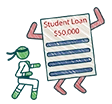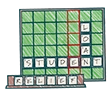Menu

CALL FOR A FREE CONSULTATION
Exceptional Legal Representation Throughout
Long Island and New York, Since 1993.

CALL FOR A FREE CONSULTATION
Exceptional Legal Representation Throughout
Long Island and New York, Since 1993.










As Benjamin Franklin famously said, “In this world, nothing can be said to be certain, except death and taxes.” This phrase has since evolved to include student loans, as the growing financial burden of education is now a significant reality for many. With most jobs today requiring a bachelor’s degree, the total amount of student loan debt in America has soared to over $1.64 trillion in federal loans and $124.65 billion in private loans. The average amount of student loan debt for an American is $35,397. If you’re one of the many people with student loans, you’re not alone, and this summary offers insights into ways you can reduce the debt you have to repay.
Student loans fall into two categories: federal loans and private loans. Federal loans are backed by the government and are subject to strict federal oversight, making it easier to find affordable repayment plans. Private student loans, on the other hand, are provided by private lenders to cover the gap between educational and living costs beyond what federal loans can fund. These loans generally have stricter terms and fewer options for long-term relief.
Due to the federal oversight of federal loans, it is typically easier to find affordable repayment solutions. However, private loans tend to be more difficult to manage, with fewer options for long-term relief. To explore the different ways we can help with your student loans, please continue reading our Student Loans Summary.

Our office is here to help you find a fair settlement for your student loans by negotiating with your lenders on your behalf. While negotiating an affordable payment plan can be challenging and time-consuming, our expertise ensures that you will get the best options available.
Federal loans are currently deferred, with no payment due until after September 30, 2022. You might not be required to pay if you are currently enrolled in a repayment plan, but you should check with your lender to be sure before deciding not to send in your student loan payments.
We have modified, rehabilitated, or consolidated federal student loans for students in default and will keep doing so..
To help you manage an affordable monthly payment, our office can work with your lender to create a repayment plan based on your income alone or on both your income and expenses. If this is your first time applying for a better student loan repayment plan and you haven’t missed payments on a previous plan, we can help you apply for an Income-Based Repayment (IBR) plan.
 Under an IBR, the borrower’s payments are based on their gross annual income from the previous year. You will pay more if your income increases, but less if your income decreases. This is an excellent, affordable option for federal student loans because any remaining unpaid balance is forgiven after 240 payments or after 20 years of consistent payments.
Under an IBR, the borrower’s payments are based on their gross annual income from the previous year. You will pay more if your income increases, but less if your income decreases. This is an excellent, affordable option for federal student loans because any remaining unpaid balance is forgiven after 240 payments or after 20 years of consistent payments.
If you are unable to prove any income, you may qualify for a very low monthly payment. Our office assists students with enrolling in IBR and maintaining these repayment plans for a recurring legal fee, as failing to do so could result in losing the benefits of this financial strategy if you ever default.
Our team can assist you in negotiating with your lenders to establish a manageable monthly payment plan.
COVID-19 Update: Payments for private loans are still due and have not been deferred. However, you may request a deferment on a case-by-case basis, depending on your situation and whether COVID-19 has impacted your ability to make timely payments.
 Our office can assist you in getting your private student loans out of default by helping with loan modifications and consolidation. Our goal is to bring your loans current with a payment plan that works for you.
Our office can assist you in getting your private student loans out of default by helping with loan modifications and consolidation. Our goal is to bring your loans current with a payment plan that works for you.
We will work to reduce your monthly payment and make it more manageable by altering your loan in various ways. While private lenders may have limitations in adjusting loan terms, our office will present your financial constraints and any exceptional circumstances to explore all available modification options. Additionally, we can help you refinance your student loan, subject to credit requirements; for more information, refer to the Refinancing Section.
Our office can help modify your federal and private student loans to better terms. Whether you’re looking for a shorter term to reduce interest over the life of the loan, a longer term with lower monthly payments, or a lower interest rate, we can work to refinance your loan on your behalf.
 Contrary to common belief, both federal and private student loans can be negotiated and partially discharged through bankruptcy. To qualify for an undue hardship discharge, you must demonstrate the following:
Contrary to common belief, both federal and private student loans can be negotiated and partially discharged through bankruptcy. To qualify for an undue hardship discharge, you must demonstrate the following:
Our office can present these mitigating circumstances in a Chapter 7 Bankruptcy to show that you cannot repay your student loans and that they should be discharged, in whole or in part.
In Chapter 13 bankruptcy, we can create a plan to settle your debts and reduce payments for the first five years. Once the plan concludes, payments may increase, but you can reapply for Chapter 13 as many times as needed to pay off your student loans.
 Starting January 27, 2020, borrowers in the Southern District of New York must participate in Student Loan Mediation with their lenders before pursuing student loan litigation through bankruptcy. This means lenders and borrowers must first seek mutually agreeable repayment options before filing a lawsuit. Although this procedure is not yet implemented in the Eastern District of New York, it could eventually influence how student loans are handled across New York and within the New York Court of Appeals.
Starting January 27, 2020, borrowers in the Southern District of New York must participate in Student Loan Mediation with their lenders before pursuing student loan litigation through bankruptcy. This means lenders and borrowers must first seek mutually agreeable repayment options before filing a lawsuit. Although this procedure is not yet implemented in the Eastern District of New York, it could eventually influence how student loans are handled across New York and within the New York Court of Appeals.
This case, involving N.Y. State Higher Education Services Corp., et al. as defendants and Kevin Jared Rosenberg as the plaintiff (610 B.R. 454), centers on a self-represented lawyer who sought a discharge of his $221,385.49 consolidated student loan debt due to “undue hardship.” Applying the Brunner “undue hardship” standard, the court discharged all of his student loan debt.
 The court determined the plaintiff met the first prong of the Brunner Test, which states that if forced to repay student loans, the borrower must be unable to afford basic necessities and maintain a minimal standard of living. After reviewing the plaintiff’s monthly income and expenses, which showed a negative balance of $1,548.74, the court concluded that he could not repay the loan and support a minimal standard of living.
The court determined the plaintiff met the first prong of the Brunner Test, which states that if forced to repay student loans, the borrower must be unable to afford basic necessities and maintain a minimal standard of living. After reviewing the plaintiff’s monthly income and expenses, which showed a negative balance of $1,548.74, the court concluded that he could not repay the loan and support a minimal standard of living.
The second prong of the Brunner Test requires that the hardship is likely to persist for a substantial part of the loan’s life. The court found that the plaintiff’s situation, including being in default and the loan being accelerated, would likely continue throughout the duration of the repayment period.
The third prong involves whether the borrower made good faith efforts to repay the loan. The court found that the plaintiff had indeed made good faith efforts, as evidenced by his record of attempting payments, enrolling in an income-based repayment plan for over a year, and requesting forbearance five times during nearly thirteen years.
As a result, the court granted the plaintiff’s motion for summary judgment, agreeing that he satisfied the Brunner Test and that the student loan caused an undue hardship.
This ruling represents a significant development in the realm of student loans being discharged through adversarial proceedings. The defendant will likely challenge and appeal the ruling, and the appellate court will assess whether the district court erred in granting the motion for summary judgment. However, this case offers a glimmer of hope in the context of student loans, which are often a source of financial hardship.
MONDAY – FRIDAY -8.30 AM – 8.30 PM